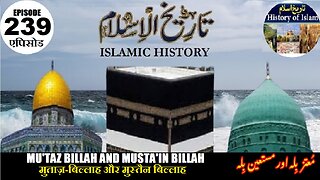Premium Only Content

P-9 History of Tomb the Al-Abbas in Karbala | تاریخ مقبرہ حضرت العباس علمدار علیہ السلام
@islamichistory813 #TombOfAlAbbas #KarbalaHistory #IslamicHeritage
History of Holiest site Tomb the Al-Abbas in Karbala
Part-9
Dekhti Aankhooon aur sountay kaanoon ko Asslamoalaikum, sisters, brothers friends and elders, In this Islamic informative video we are describing Part Nine (and Last Part) of remaining history of the Tomb of Al-Abbas in Karbala, a site that holds profound meaning for millions of Muslims worldwide. The video highlights the life and valor of Al-Abbas, emphasizing his contributions during the tragic events of the Battle of Karbala. By examining historical texts and contemporary perspectives, we aim to provide a comprehensive overview of the significance of this holy site. We are describing history of tomb and also bravely incidents in Karbala of Hazrat Abbas Alamdar (RA) in nine parts. so please watch all parts. and if you like then please share to your friends so that they also be benifit.
Sayyid Ibrahim al-Bahbahani recounted:
One week after my marriage in AH 1351, I had flu accompanied by high fever. The physicians of Najaf, including Dr. Muhammad Zaki Abazha, treated me, but uselessly. As my disease was increasing, I decided not to see any physician. A few months later, a committee of four physicians decided that I would die in a month.
In Muharram, AH 1354, my father went to a village called ‘al-Qasim’ to recite the tragic saga of Imam al-Husayn (a) in the memorial gatherings for that anniversary. My mother, who was in an incessant state of weeping, was tending me.
On the seventh night of that month, I saw in sleep a tall, good-looking man asking me to give a sermon in the memorial gathering held in that anniversary. He also asked me to go to Karbala and mention the saga of al-’Abbas there. For three times, that man asked me to do that thing. When I woke up, I told my mother of that dream. She was delighted and decided to take me to the holy shrine of al-’Abbas. None responded to her suggestion because of the bad state I had. Finally, some relatives decided to put me in a coffin because I was unable to ride on anything.
As soon as we arrived in the holy shrine, I slept there and saw the very man who had reproached me for delay and asked me to recite the saga of al-’Abbas. I woke up terrified, but I immediately fainted. When I recovered consciousness, I was very healthy. Everybody who was in the holy shrine, the yard, and even the market gathered around me with cries of Allahu Akbar and La Ilaha illa (A)llah. Policemen attended, asked people to leave, and took me out to the hall facing the holy sanctuary…26
Referring to this charisma, many authors, such as Sayyid Salih al-Hilli, Muhammad ‘Ali al-Ya’qoubi, Sheikh ‘Ali al-Jeshi, Sayyid Hassoun Radi al-Qizwini, Sayyid Muhammad Reda al-Hindi, Sheikh Abd-’Ali Husayn, Ja’far at-Turaifi, Sheikh Kadim as-Sudani, Sheikh Hasan Sebti, Sayyid Nuri Salih al-Baghdadi, and others, composed poetic verses that perpetuated the occurrence.
‘Mkhelef’ was the name of a man who lived in al- Muhammara27 and was inflicted with a chronic illness in his legs which were as thin as fingers. Most of the inhabitants of al- Muhammara knew that man and his illness. Creeping on his buttocks and hands, Mkhelef used to be present at the memorial gatherings held for commemorating the tragedy of Imam al- Husayn (a). He used to sit under the mimbar with his legs extended.
Sheikh Khaz’al, chief of the province of al-Ahwaz southern Iran, had a Husseiniyya in which the ceremonies of the consolation of Imam al-Husayn were held. On the seventh day of Muharram that year, people, as usual, stood up for slapping on chests as expression of their deep sadness for the martyrdom of al-’Abbas. In the midst of their slapping and shouting, the crowds observed that Mkhelef was standing among them shouting, ‘I am Mkhelef. Al-’Abbas enabled me to stand up on my legs.’
As they noticed this miracle, people rushed to Mkhelef and tore his clothes as each one tried to take a piece of it for seeking blessings. Sheikh Khaz’al then ordered his officials to take Mkhelef to one of the rooms of the Husseiniyya and prevent people from reaching him.
When people asked him what had happened, Mkhelef recounted:
As people were slapping and shouting, I fell into a slumber under the mimbar. I saw a tall, handsome man on a horse asking me: ‘Mkhelef, why do you not slap for al-’Abbas?’ ‘Sir,’ I answered, ‘I cannot because of that which you see.’ As the horseman ordered me to stand up, I asked him to give me his hands so that they will help me stand up. He said, ‘I do not have hands! You may hold on the stirrup of the horse and stand up.’
Thus, the holy tomb of al-’Abbas has been, day and night, visited by various kinds of people: needy who seek God’s charity, an ailing person who searches for cure from the Lord, a grieved one who hopes for relief from God, the terrified who seeks succor, and the affected who seeks solution - all through the intercession of al-’Abbas. All return with pleasure and a happy heart as the intercession of al-’Abbas, as usual, achieves success.
so sisters brothers and friends, inshaAllah tomorow we will be described History of The Sayyidah Ruqayya Mosque in Damascus Syria. Allah Hafiz
=============================
-
 14:42
14:42
ISLAMIC HISTORY
1 day agoIslamic History Episode 239 Mu'taz-Billah & Mustain Billah मुताज़ और मुस्टेन معتز بلہ اور مستعین بلہ
17 -
![🔴[LIVE] Sept RCP #27💜 [English Chat] 😍DGG-a-Thon! Forever Skies maybe other game later ....💜](https://1a-1791.com/video/fwe2/ee/s8/1/0/t/e/m/0temz.0kob-small-LIVE-Sept-RCP-27-English-Ch.jpg) LIVE
LIVE
Deaf Gamer Girl
36 minutes ago🔴[LIVE] Sept RCP #27💜 [English Chat] 😍DGG-a-Thon! Forever Skies maybe other game later ....💜
60 watching -
 1:00:24
1:00:24
Jeff Ahern
7 hours ago $6.66 earnedThe Sunday Show with Jeff Ahern
41.4K15 -
 LIVE
LIVE
OhHiMark1776
4 hours ago🟢 09-28-25 ||||| Act 3 Continue ||||| Baldur's Gate 3 (2023)
172 watching -
 2:04:33
2:04:33
DooM49
4 hours ago12 Days until Battlefield 6
26.7K1 -
 17:23
17:23
Russell Brand
2 days agoThey couldn't handle this...
147K325 -
 18:18
18:18
DeVory Darkins
1 day ago $41.87 earnedPortland gets NIGHTMARE NEWS as Trump orders Troops to crush violent rioters
86.5K383 -
 1:32:21
1:32:21
JTtheSG
5 hours agoLIVE Replay - Ready To Play VOID BREAKER
22K -
 4:43:17
4:43:17
DoldrumDan
7 hours agoNEW STREAM SCHEDULE 3PM EST TO 7PM EST EVERY DAY
44.1K5 -
 3:45:41
3:45:41
Sgt Wilky Plays
6 hours agoSunday Finals | Regiment Donor Drive
25.8K1